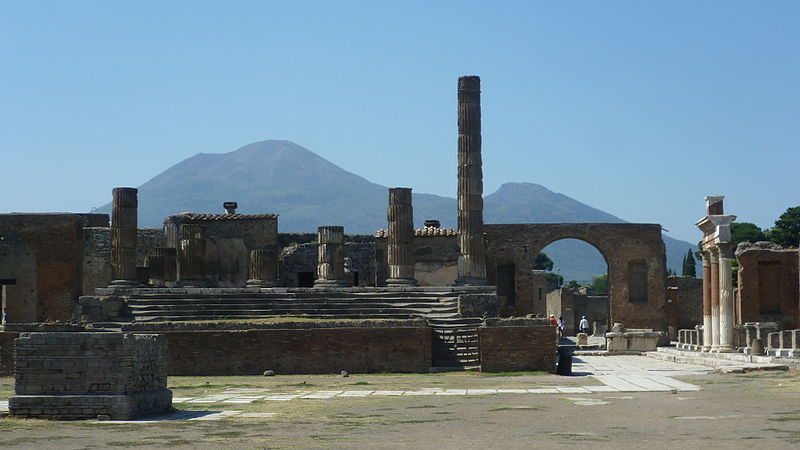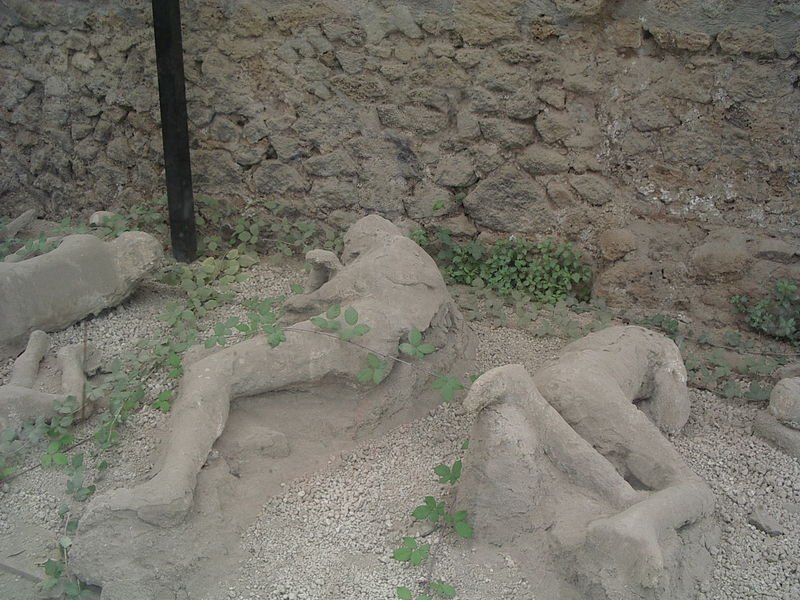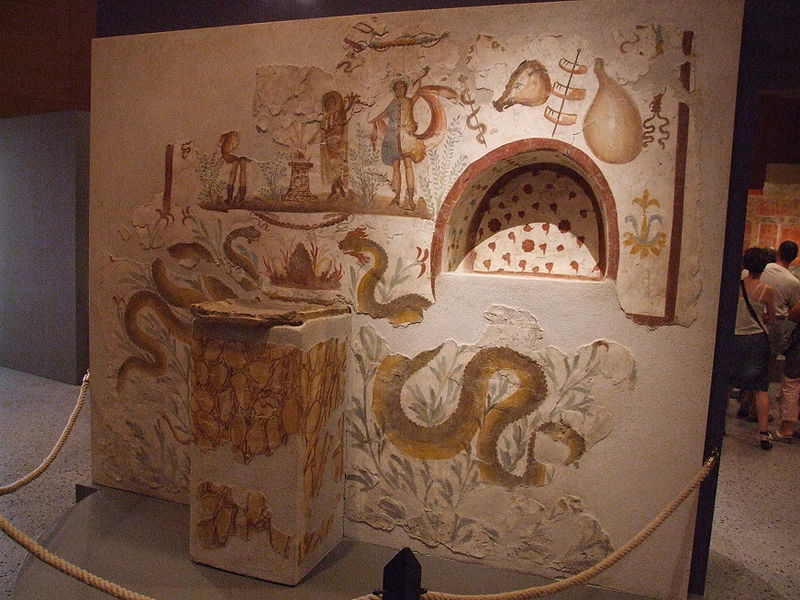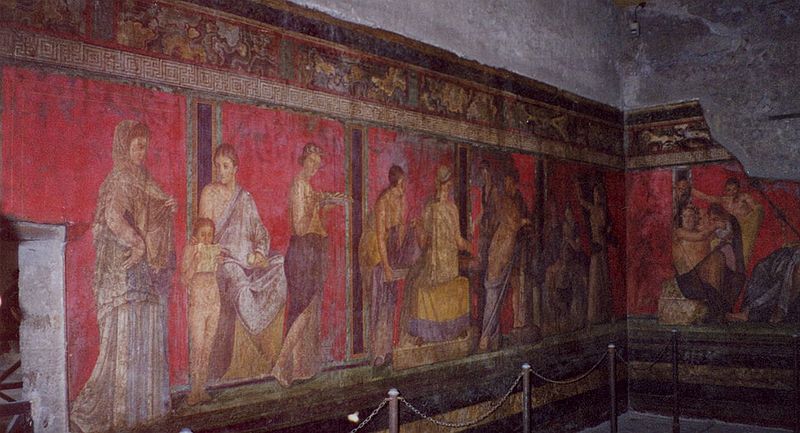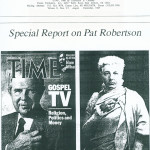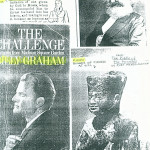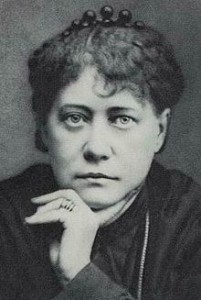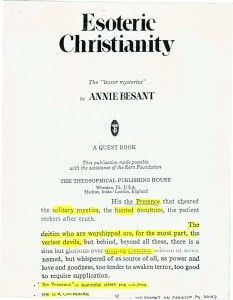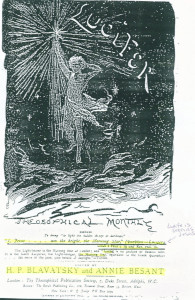Pompeii is located south of Italy. The area was originally colonized by the Greeks in the 8th century, and had been inhabited continuously since it was buried by ash from a volcanic eruption in 79 A.D. Mt. Vesuvius was a volcano nearby that was thought to be dormant. Although it erupted unexpectedly, there was a warning of renewed volcanic activity in the area in the form of an earthquake which decimated the city in 62 A.D.
As in many Roman cities, religion was pervasive in the everyday life of Pompeii. Pompeii’s status as a center of maritime trade helped to foster a diverse range of beliefs within the city. In addition to the state-sponsored worship of the traditional Olympian gods and the cult of the emperor, the people of Pompeii found spiritual fulfillment through a number of mystery cults. In the mystery cults, a person showed particular devotion to one deity, who took on the role of a savior figure to his or her followers by helping them endure life and by promising them a fulfilling and pleasant afterlife. (1; Grant)
The two most significant cults in Pompeii were the Cult of Isis and the Cult of Bacchus. Isis was the Egyptian goddess of life, fertility, and rebirth. She was both sister and wife to the god of the underworld, Osiris, who was also worshiped by the cult of Isis. Due to its large amount of influence, the temple to the Cult of Isis was the only temple that was fully restored after the earthquake of A.D. 62. It was surrounded by a high wall that hid its ceremonies from anyone outside it. It contained an initiation hall, lodgings for its full-time priests, a room for banquets and gatherings, and an underground chamber containing a basin of holy water from the Nile.
At dawn the priests held a ceremony to celebrate the resurrection of Osiris, and in the afternoon, priests performed the Rites of the Water, as water was seen as the source of all life. The cult also had yearly festivals which were designed to be sensational and dramatic. (2; Grant).
Dionysus is the most frequently represented god in all art. He was adopted by the Romans as Bacchus as early as the third century B.C. Dionysus was first and foremost the god of wine who produced both drunkenness and divine ecstasy. Bacchus was the Roman god of wine. He, like Pompeii’s patron gods Jupiter, Venus, and Apollo, was derived from the Greek pantheon of Olympian gods. When the festivals to the god Bacchanalia had degenerated over time into large orgies, the Roman senate forbade the celebrations in the year 186 B.C. on the grounds that they threatened public order. The main goal of the members of this cult was to escape reality into a state of “mystic communion” with the god (3; Grant).
In Pompeii, house entrances were often decorated with a mosaic or painting of a dog to serve as the house’s protector, or a representation of the fertility god Priapus for prosperity. There was also a household shrine called a lararium which a family god was placed. It contained a shelf for idols and snake pictures for good luck. In the dining room, decorations with images of skeletons and death were meant to increase enjoyment of the meal with an Epicurean attitude that one must enjoy life before death.
 Temple of Jupiter with Visuvius in background.
Temple of Jupiter with Visuvius in background.
Right outside the city are family tombs, which advertise the wealth of the family that erected them, and which where kept outside the city walls because of Roman concerns about ritual purity. The downtown area of the city contained the Forum, where the temple of Jupiter, the city lararium, and the court and commercial buildings were. Pompeii was the center of the wool trade and the largest building was the lavish wool merchant’s guild, which was built by a wealthy woman.
In the “Mystery Villa,” dedicated to the worship of Dionysus, there is a mysterious cycle of frescoes which represent some of the greatest paintings of the past. Dating about 50 B.C., this cult room in the home of a patrician family is a precious document of initiation rites as well as the refined taste of the family who commissioned the paintings. The room is decorated with almost life-sized figures set in a shallow space placed against a vibrant red, undecorated wall. The focus of the room is the image of Dionysus and his mythological and human figures, the secret rites for young women are revealed, reading from a sacred text, purification, the flagellation of the initiate with ecstatic dancing, the revealing of the sacred phallus and finally, the reward of a mystical marriage to the god. After initiation, that included suffering and mystical marriage with the god, worshipers were promised resurrection.
The veiled domina of the house who must have been a member of the Dionysiac cult watches from the corner wall. Adjoined to her marriage chamber, the room with its large figures which do not cast shadows and are set against a flat, red background, gives an atmosphere of both mystery and majesty in keeping with the secret rites. The artist also draws on human features in the painting of the faces of the south Italian women shown here.
Myth and reality are intertwined in this original masterpiece. Dionysus was also a benign god, who like Osiris, answered the human search for meaning beyond this life. Many aspects of the Osiris/Dionysus symbolism were assimilated several centuries later into Christian thought and art. The Dionysus cult spread over the Graeco-Roman world as far east as India in the wake of the conquests of Alexander the Great. Alexander left in his wake great Hellenistic cities. He died in Babylon in 323 B.C., but his body was hijacked by Ptolemy I and removed to Alexandria, the port city that Alexander founded in 331 B.C. and the first to bear his name.
At the mouth of the Nile, under the Ptolemies and the Romans, Alexandria became the main port of the eastern Mediterranean for state and private shipping and the second largest city in the Roman empire. Rome depended on Egypt for wheat to feed her masses and luxury items for her wealthy. (4)
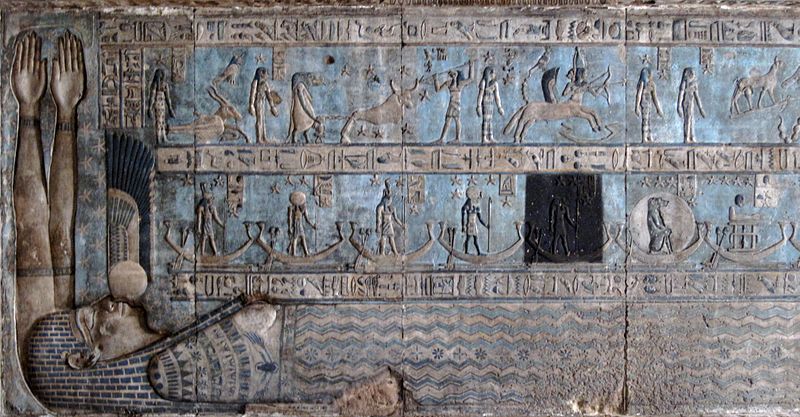 Ptolemaic Egyptian Constellations at Dendera.
Ptolemaic Egyptian Constellations at Dendera.
Egyptian Sacred Ceremonial: For first advances the Singer, bearing some one of the symbols of music. For they say that he must learn two of the books of Hermes, the one of which contains the hymns of the gods, the second the regulations for the king’s life. And after the Singer advances the Astrologer, with a horologe in his hand, and a palm, the symbols of astrology. He must have the astrological books of Hermes, which are four in number, always in his mouth.
The earliest Zodiac found in Egypt dates to the 1st century BCE, the Dendera Zodiac. Ptolemy’s work, the Tetrabiblos, laid the basis of the Western astrological tradition. Astrology was developed into a system of divination approximately 3,000 B.C, by the Babylonians, who gazed at the heavens from their zigurats, a type of staired tower, and began to worship the individual planets, moon, stars, as gods and goddesses. Although it was rejected by the early Church, it was revived during the Rosicrucian Enlightenment and the Renaissance.
In 332 BCE, Egypt came under Greek rule and influence. In ”Alexandrian Egypt” the Babylonian astrology was mixed with the Egyptian tradition of Decanic astrology to create Horoscopic astrology. This contained the Babylonian zodiac with its system of planetary exaltations, the triplicities of the signs and the importance of eclipses. Along with this it incorporated the Egyptian concept of dividing the zodiac into thirty-six decans of ten degrees each, with an emphasis on the rising decan, the Greek system of planetary Gods, sign rulership and four elements. (16; Holden)
The Hermetic texts were also put together during this period, but when Hermeticism was no longer endorsed by the Christian church, it was driven underground and several Hermetic societies were formed.
Many Hermetic, or Hermetically influenced, groups exist today. Most of them are derived from Rosicrucianism, Freemasonry, or the Golden Dawn.
H.P. Blavatsky; The Theosophical Society.
“As our earth has its hierarchy of terrestrial planetary spirits, so has every other heavenly body. The highest planetary spirit ruling over any globe is in reality the “Personal God” of that planet and far more truly its ‘over-ruling providence’ than the self-congratulatory Infinite Personal Deity of modern Churchianity.” (H. P. Blavatsky, “The Theosophical Glossary,” p. 255)
The Esoteric perspective means the “inner” (eso-), in the sense of the inner consciousness; the contemplative, Gnostic, wisdom perspective, as opposed to the “outer” (exo-) or Exoteric, i.e. the outer or surface or everyday consciousness. Esoteric and Exoteric are the two basic ways of looking at reality – the intuitive and the rational.
To the disciples of the ancient mystery religions, each planet is governed by a planetary spirit. The concept of a personal God who is the Creator and Ruler of all is held in contempt and a hierarchy of planetary gods is thought to rule the solar system. In esoteric teaching, the planetary gods meet in councils to rule the universe and intermittently intervene in the affairs of the earth in order to assist man in his progress toward the evolved state. In the early days it was carefully hidden from the masses of ordinary ignorant converts. “Inner Christianity” had adopted the secret wisdom of the ancients, handed down from generation to generation.
Anna Bonus Kingsford used chloroform to alter her consciousness to open up to the underworld so that she could work through dreams and magic. She and her companion, Edward Maitland, identified “the spiritual alchemy” of the Gnostic and Hermetic teaching of the early Christian world along with the wisdom of the Neoplatonist philosophers and Muslim Sufis. In the 1880s they founded the “Hermetic Society” and had close contact with Theosophist Madame Blavatsky and the “Order of the Golden Dawn.” HermeticismAnnie Beasant later took over after the death of Blavatsky.
Cosmology is the study of the cosmos. All cosmologies have in common an attempt to understand the implicit order within the whole of being. In this way, most religions and philosophical systems have a cosmology.
Today in Evangelical circles as well as New Age circles, the true origins of Christianity is believed to have been suppressed. The true Christians are said to actually be Gnostics who will eventually restore the records and customs of ancient wisdom. Through a variety of media, especially books, the record is being “set straight” on the events of the life to Jesus Christ.
The “shadow of Christianity,” as ecumenical theologian and mystic Matthew Fox puts it, has occurred in the last 500 years as Christianity has lost its connection to its cosmology. (14)
Nancy Ortberg at Westmont College Commencement 2012, “Your generation has taken the word justice and blown the dust off of it… make it a lifestyle. …When Jesus came he mostly talked about the small things… people doing small things might be able to make a dent and put a crack in the cosmos. ..Thomas Merton says that the highest expression of a person’s intellectual and spiritual life is contemplation.” Nancy Ortberg, Westmont College (video clip)Commencement, 2012.
Thomas Merton, is promoted at Willow Creek in women’s ministries and quoted by Nancy Ortberg. Merton says one can work within the Christian traditions but view universalism as the broader truth: “[The contemplative] has a unified vision and experience of the one truth shining out in all its various manifestations. He does not set these partial views up in opposition to each other, but unites them in a dialectic or an insight of complementarity.”
The revisionist account of the Incarnation is now available in Christian bookstores: Max Lucado, a popular Evangelical author, wrote a short novel called “Cosmic Christmas” which reduces Jesus Christ to a “divine spark” which is implanted in a worthy human being(pp. 32, 33, 76). The hidden message of “Cosmic Christmas” closely follows New Age and Gnostic Theurgy where angels are stars or planetary spirits which will guide a willing humanity to receive the Luciferic initiation.
His story tells of “the Light” which disappears from a vial that has been entrusted to Gabriel, and presently impregnates Mary with “the essence” which will be called Son of God which portrays, in story form, the Gnostic principle that human beings are, through their own merits, incipient vessels of the divine essence.
An important Gnostic doctrine is the ultimate salvation of Lucifer. In the Afterward, Lucado does not decisively state that Lucifer can never be saved, but rather equivocates, leaving room for the remote possibility: “Finally, the Bible tells no story of a throne room encounter where Lucifer is offered a second chance. But the Bible does contain page after page show God giving grace to the scalawags and turncoats of the world. He seems more willing to give grace than we are to seek it. Such divine love leaves me to wonder one thing more: if the old snake himself sought mercy, wouldn’t he too, find it where millions have—at the foot of the cross of Christ?” (pp. 109, 110)
The removal of Lucifer’s judgment in Isaiah 14 leaves room for innumerable heresies, including ultimate salvation. This aberrant doctrine was proposed, c. 250 A.D., by Clement and Origen of the Gnostic cult of Alexandria, Egypt. Although they are promoted in our day as “Church Fathers,” they produced copies of the Scriptures which were corrupted with Gnostic doctrine. Clement of Alexandria’s false gospel is also found in his Homilies: “After a preliminary examination of all possible different attempts at a solution of the problem of evil, the attempt is here made to represent the devil as an instrument of God. Christ and the devil are the two hands of God, Christ the right hand, and the devil the left, the devil having power over this world—epoch and Christ over the next. The devil here assumes very much the characteristics of the punishing and just God of the Old Testament, and the prospect is even held out of his ultimate pardon.” (“Clementine Homilies,” #3, p. 154)
(click on image to enlarge)
As in New Age books, Lucado uses the archangel as the agent who brings “the Light” to Mary. In Holy Scripture, Gabriel’s mission is to simply announce to Mary that she has been chosen to bear the Son of God, the incarnation being the work of the Holy Spirit alone and that moment is never recorded in Scripture. The Council of Nicea was held in 325 A.D. to counter various systems of Gnosticism, a 2nd century dualistic religion which denied that Christ had had a completely human life; He was said by some Gnostics have passed through the body of Mary as light passes through a window.
Gnostics believe that the world of matter in which the human soul is imprisoned is evil and that man’s spirit is meant to partake int he divine nature of the universal spirit. “Gnosis” is the perception by man that he contains a spark of God and the realization of his need to awaken from his inferior mode of physical existence to a full consciousness of his divinity, which has become ensnared in matter. Alchemy is esoteric philosophy which seeks to release the soul via the ascendancy of spirit over matter.
The four elements of ancient cosmology are earth, air, fire and water. In alchemy, a fifth essence is believed to enhance these material elements. The four elements and the quintessence which elevates them to a higher plane are described in the following: “The alchemists’ spiritual focus on essence, rather than matter, was supposed to increase the proportion of the fifth essence in the make-up of the entire world. The quintessence was thought to be present within each of the four elements as its sublime creature: in the water as a dolphin, in the fire as the phoenix, in the air as the eagle and on earth as the human race. At the same time, the quintessence was believed to envelop and extend beyond each of the others. The graphic symbol corresponding to the quintessence is the pentacle.” (10; Biederman)
Lucado’s “Cosmic Christmas” opens and closes with illustrations of the planet Saturn and a blazing star. Other theosophists have confirmed that the blazing star is commonly seen by the initiate during a valid initiation (11; Bailey). The pentacle is also the logo of the Theosophical Society. It’s founder, H.P. Blavatsky identifies the pentacle as: “Any geometric figure, especially double equilateral triangle, the six-pointed star, (like the theosophical pentacle).” (7; p. 251).
In “The Hidden Life of Freemasonry,” by theosophist Charles Leadbeater, the blazing star is said to be properly six-pointed. The Masonic Prince Adept, Albert Pike stated, “… the blazing star… represents [the] Star of Horus… Morning Star… Star of Set… Lucifer.” (12; Burns) Since the quintessence is symbolized by the pentacle or six-pointed star, we may infer that the essence which enhances material elements is Lucifer, symbolized in occult language by the eagle or phoenix. The Masonic axiom “as above, so below” is particularly relevant to the Christmas season, the event being the birth of the sun-god or Gnostic Christ and the terrestrial event the “birthing” of the baby “Christ” within willing human vessels.
In “Rosicrucian Cosmo-Conception: Mystic Christianity,” Rosicrucian Grand Master, Max Heindels, identifies December 24, 25 as the most potent time of the astrological year and the ideal time for initiation rites: “The night between the 24th and 25th of December is the holy night, par excellence, of the entire year. The zodiacal sign of the Immaculate Celestial Virgin stands upon the eastern horizon near midnight. The sun of the new year is then born and starts upon his journey form the southernmost point toward the northern hemisphere, to save that part of humanity (physically) from the darkness and famine which would inevitably result if he were to remain permanently sought of the equator…The spiritual influences are strongest, in the north, at midnight of the 24th of December…It would then be easiest for those who wish to take the definite step toward initiation to get in conscious touch with the spiritual time….The blazing star is ever there to guide him.” (13; p. 390)
References/Related
- Michael Grant, “Cities of Vesuvius: Pompeii and Herculaneum,” 1971.
- Ibid., p. 98.
- Ibid., pp. 98-108.
- Hellenic Communication Service, L.L.C.: http://www.hellemserve.com/mccannlecture6.html
- Michael Howard, “The Occult Conspiracy;” p. 24.
- Max Lucado, “Cosmic Christmas.”
- Mary Fairchild, The Theosophical Society.
- H. P. Blavatsky, “The Theosophical Glossary.
- Clementine Homilies
- Hans Biederman, “The Dictionary Of Symbolism: Cultural Icons & The Meanings Behind Them,” Meridian Books, 1989, 1994, p. 276)
- Alice Bailey, “Initiation: Human & Solar,” Lucis Publishing, 1922, p. 107.
- Cathy Burns, “Hidden Secrets of the Eastern Star,” pp. 52-23.
- “Cosmic Christmas Part II: Saturn,” Watch Unto Prayer.
- Mary Fairchild, Nancy Ortberg Speaks at Willow Creek: Deep Ecumenism; Spring 2012.
- Wikipedia, “Astrology.”
- Holden, James Herschel, 1996. A history of horoscopic astrology. American Federation of Astrologers, Inc; pp. 11-13.
- Mary Fairchild, Freemasonry: The One Eternal Religion.

